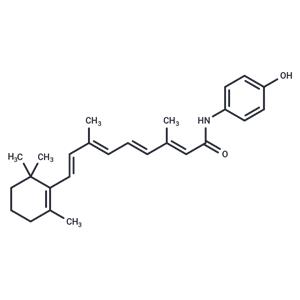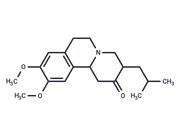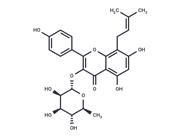| Name | Fenretinide |
| Description | Fenretinide (4-HPR) is an orally-active synthetic retinoid derivative with potential antineoplastic and chemopreventive activities. |
| Cell Research | Fenretinide is dissolved in DMSO. Standard XTT assay is used to determine cell viability. For fenretinide-only treatments, cells are plated in 96-well plates at 750,000 cells/mL and 100 μL/well. After 4 h, treatments are added on 50 μL/well obtaining a final density of 500,000 cells/mL and final volume of 150 μL/well. Four replicates are used per experimental condition. XTT reagent mixture is added 4 h before the end of selected treatment period and absorbance at 490 nm is determined per each well. A slightly modified protocol is used for analysis of the effect of myriocin (final concentration of 100 nM) or antioxidant on Fenretinide treatment. Briefly, cells are seeded on 60 mm culture dishes and myriocin or antioxidants added after 4 h. Fenretinide treatment is added 2 h later and cells are plated in quadruplicates in 96 well plates (150 μL/well). |
| In vitro | Fenretinide demonstrates both immediate and sustained antitumor effects across several T-ALL cell lines and inhibits DES activity in CCRF-CEM leukemia cells, leading to increased endogenous cellular dhCer levels in a dose- and time-dependent manner. This includes (3 µM)-induced dhCer accumulation in CCRF-CEM and Jurkat cells [1]. Additionally, fenretinide enhances insulin signaling by protecting against ceramide-related inhibition and mitigates lipid-induced declines in insulin-stimulated glucose uptake [2]. It also effectively halts OVCAR-5 cell proliferation and viability at doses above 1 µM, achieving 70-90% growth inhibition at 10 µM, and notably impairs OVCAR-5 invasion following a 3-day preincubation period with 1 µM. Furthermore, endothelial cells exposed to 1µM 4-HPR fail to form tubular structures, instead creating small cellular clusters [4]. |
| In vivo | Fenretinide (10 mg/kg, i.p.) selectively inhibits ceramide accumulation HFD-fed male C57Bl/6 mice. Fenretinide treatment improves glucose tolerance and insulin sensitivity as determined by both glucose and insulin tolerance tests[2]. The addition of 25 mg/kg ketoconazole to Fenretinide increased 4-HPR plasma levels in NOD/SCID mice[3]. |
| Storage | Powder: -20°C for 3 years | In solvent: -80°C for 1 year | Shipping with blue ice. |
| Solubility Information | DMSO : 55 mg/mL (140.47 mM)
|
| Keywords | Retinoic acid receptors | MK4016 | Inhibitor | Autophagy | RAR/RXR | Fenretinide | inhibit | MK 4016 | Retinoid X receptors |
| Inhibitors Related | Stavudine | Xylitol | Sodium 4-phenylbutyrate | Hydroxychloroquine | Guanidine hydrochloride | Taurine | Curcumin | Oxyresveratrol | Paeonol | Naringin | Salicylic acid | Gefitinib |
| Related Compound Libraries | Bioactive Compound Library | Pediatric Drug Library | Anti-Breast Cancer Compound Library | Hematonosis Compound Library | Anti-Cancer Clinical Compound Library | Drug Repurposing Compound Library | Anti-Aging Compound Library | Bioactive Compounds Library Max | Anti-Cancer Drug Library | Anti-Cancer Active Compound Library |

 United States
United States



